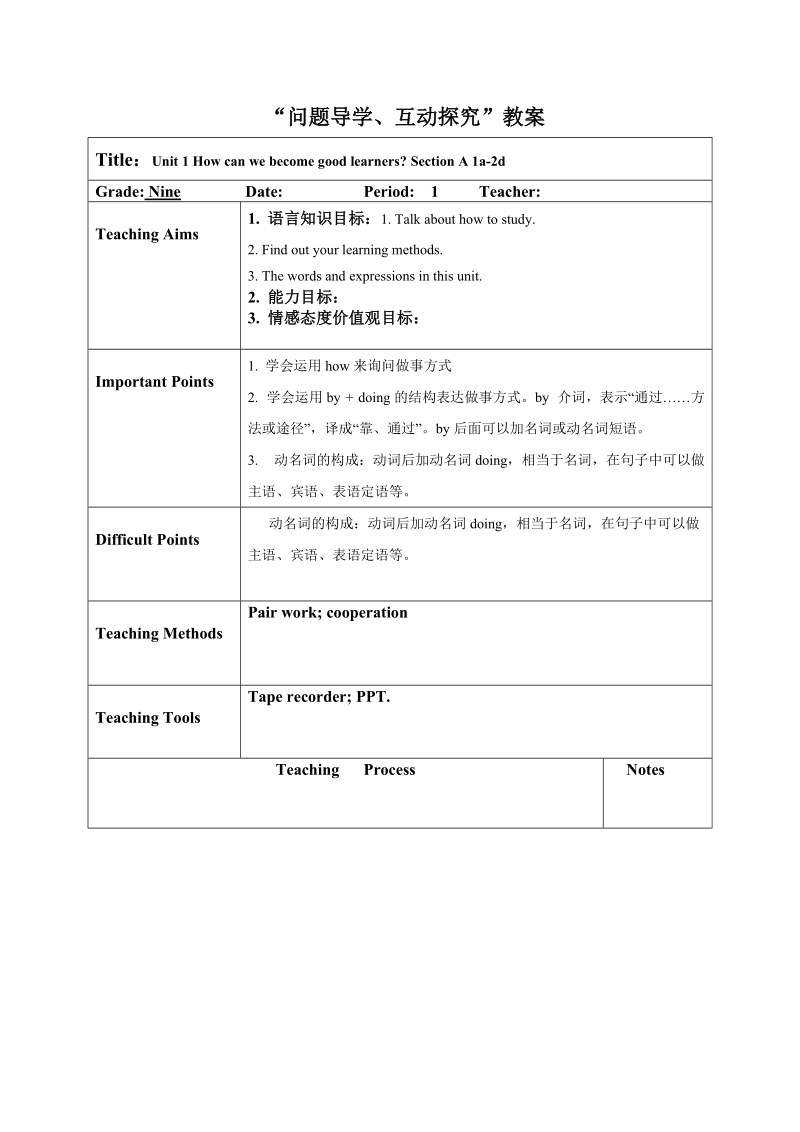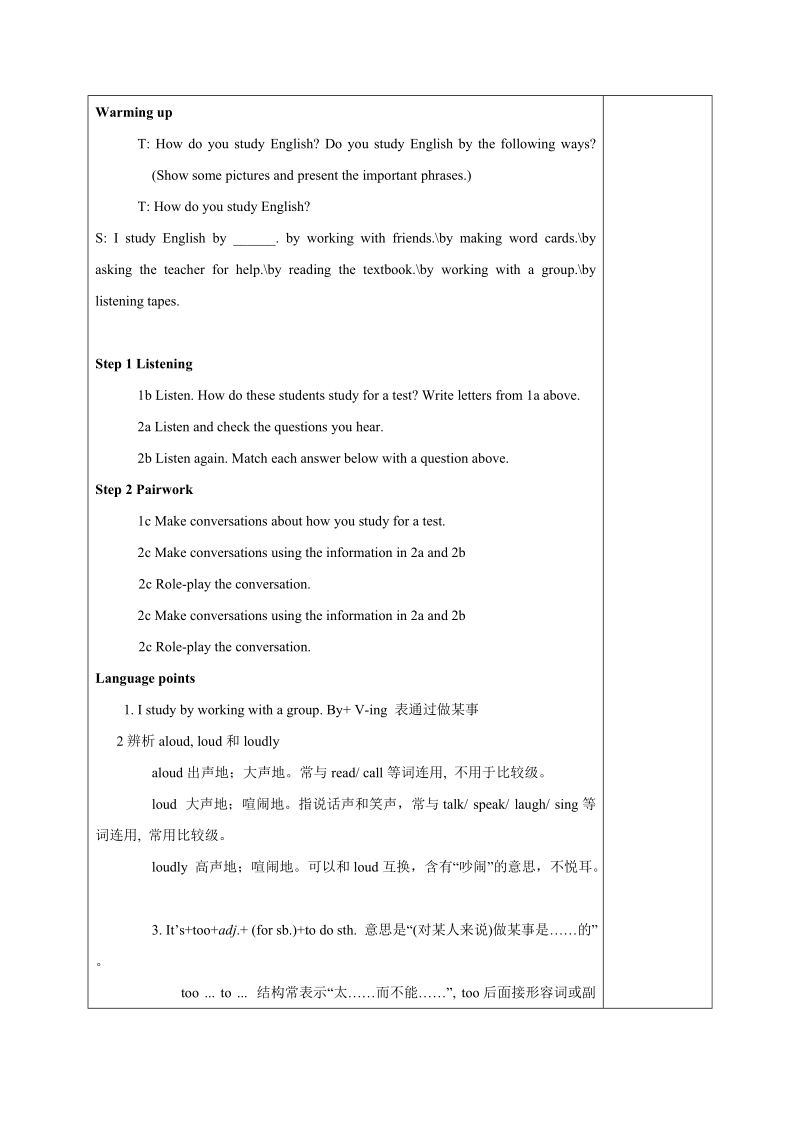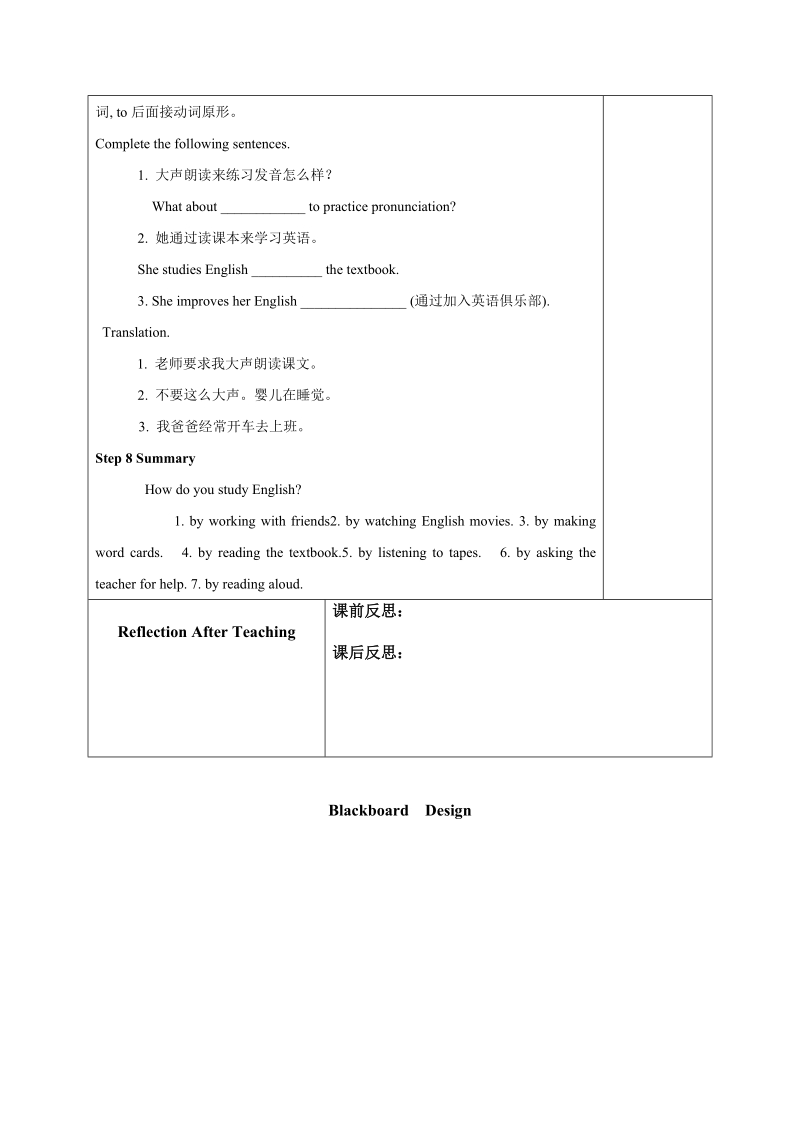 人教版新目标九年级英语Unit1单元教案
人教版新目标九年级英语Unit1单元教案
《人教版新目标九年级英语Unit1单元教案》由会员分享,可在线阅读,更多相关《人教版新目标九年级英语Unit1单元教案(10页珍藏版)》请在七七文库上搜索。
1、 “问题导学、互动探究”教案Title:Unit 1 How can we become good learners? Section A 1a-2dGrade: Nine Date: Period: 1 Teacher:Teaching Aims1. 语言知识目标:1. Talk about how to study. 2. Find out your learning methods. 3. The words and expressions in this unit.2. 能力目标:3. 情感态度价值观目标:Important Points1. 学会运用 how 来询问做事方式 2. 学
2、会运用 by + doing 的结构表达做事方式。by 介词,表示“通过方法或途径”,译成“ 靠、通过”。by 后面可以加名词或动名词短语。3. 动名词的构成:动词后加动名词 doing,相当于名词,在句子中可以做主语、宾语、表语定语等。Difficult Points动名词的构成:动词后加动名词 doing,相当于名词,在句子中可以做主语、宾语、表语定语等。Teaching MethodsPair work; cooperationTeaching ToolsTape recorder; PPT.Teaching Process NotesWarming upT: How do you st
3、udy English? Do you study English by the following ways? (Show some pictures and present the important phrases.)T: How do you study English?S: I study English by _. by working with friends.by making word cards.by asking the teacher for help.by reading the textbook.by working with a group.by listenin
4、g tapes.Step 1 Listening 1b Listen. How do these students study for a test? Write letters from 1a above.2a Listen and check the questions you hear.2b Listen again. Match each answer below with a question above.Step 2 Pairwork1c Make conversations about how you study for a test.2c Make conversations
5、using the information in 2a and 2b2c Role-play the conversation.2c Make conversations using the information in 2a and 2b2c Role-play the conversation.Language points1. I study by working with a group. By+ V-ing 表通过做某事2 辨析 aloud, loud 和 loudlyaloud 出声地;大声地。常与 read/ call 等词连用, 不用于比较级。loud 大声地;喧闹地。指说话声
6、和笑声,常与 talk/ speak/ laugh/ sing 等词连用, 常用比较级。loudly 高声地;喧闹地。可以和 loud 互换,含有“吵闹”的意思,不悦耳。3. Its+too+adj.+ (for sb.)+to do sth. 意思是“(对某人来说)做某事是的”。 too . to . 结构常表示 “太而不能”, too 后面接形容词或副词, to 后面接动词原形。Complete the following sentences.1. 大声朗读来练习发音怎么样? What about _ to practice pronunciation? 2. 她通过读课本来学习英语。Sh
7、e studies English _ the textbook.3. She improves her English _ (通过加入英语俱乐部 ).Translation.1. 老师要求我大声朗读课文。 2. 不要这么大声。婴儿在睡觉。 3. 我爸爸经常开车去上班。Step 8 SummaryHow do you study English?1. by working with friends2. by watching English movies. 3. by making word cards. 4. by reading the textbook.5. by listening t
8、o tapes. 6. by asking the teacher for help. 7. by reading aloud.Reflection After Teaching课前反思:课后反思:Blackboard Design“问题导学、互动探究”教案Title:Unit 1 How can we become good learners? Section A 3a-3bGrade: Nine Date: Period: 2 Teacher:Teaching Aims1. 语言知识目标:1. Talk about how to study. 2. Find out your learni
9、ng methods. 3. The words and expressions in this unit.2. 能力目标: 3. 情感态度价值观目标:Important Points1. 学会运用 how 来询问做事方式 2. 学会运用 by + doing 的结构表达做事方式。by 介词,表示“通过方法或途径”,译成“ 靠、通过”。by 后面可以加名词或动名词短语。3. 动名词的构成:动词后加动名词 doing,相当于名词,在句子中可以做主语、宾语、表语定语等。Difficult Points动名词的构成:动词后加动名词 doing,相当于名词,在句子中可以做主语、宾语、表语定语等。Tea
10、ching MethodsPair work; cooperationTeaching ToolsTape recorder; PPT.Teaching Process NotesStep 1 Give the students some pictures, then let them talk about:How do you study English?I study by _.Step 2 Look at the picture on page 3, then let the students talk about:The girl is Wei Fen. What is she doi
11、ng? Can you guess how she studies English ?Step 3 Finish 3a: Read the passage about Wei Fen and answer the questions.1) Why did Wei Fen find it difficult to learn English?2) What did she do in English class?3) What is the secret to language learning?Step 4Finish 3b: Complete the sentences with what



- 配套讲稿:
如PPT文件的首页显示word图标,表示该PPT已包含配套word讲稿。双击word图标可打开word文档。
- 特殊限制:
部分文档作品中含有的国旗、国徽等图片,仅作为作品整体效果示例展示,禁止商用。设计者仅对作品中独创性部分享有著作权。
- 关 键 词:
- Unit1a
 七七文库所有资源均是用户自行上传分享,仅供网友学习交流,未经上传用户书面授权,请勿作他用。
七七文库所有资源均是用户自行上传分享,仅供网友学习交流,未经上传用户书面授权,请勿作他用。
文档标签
- 励耘九年级英语
- 人教版新目标九年级英语Unit2单元教案
- 人教版新目标九年级英语Unit1单元教案
- 人教版新目标九年级英语Unit4整单元教案
- 人教版新目标九年级英语Unit1 period4教案
- 人教版新目标九年级英语Unit1 period3教案
- 人教版新目标九年级英语Unit1 period6教案
- 人教版新目标九年级英语Unit5 全单元教案
- 人教版新目标九年级英语Unit1单元试题及答案
- 人教版新目标九年级英语Unit1 period5教案
- 人教版新目标九年级英语Unit1 period2教案
- 练习九1教案
- 新目标人教版九年级英语Unit1全单元优秀课件
- 人教版新目标九年级英语Unit1 period1教案
- 人教版英语九年级
- 新目标人教版九年级英语Unit1全单元教案
- 新目标九年级英语第一单元试题
- 新目标英语九年级unit1
- 人教版新目标九年级英语Unit6单元教案



 浙公网安备33030202001339号
浙公网安备33030202001339号
链接地址:https://www.77wenku.com/p-35718.html